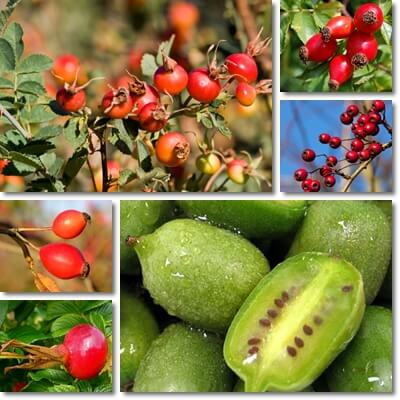Of all the fruits to eat this winter that are also healthy, berries are one of the best options, especially if they’re in season. Colorful, flavorful, sweet or sour or with pleasant bitter flavors, they do not disappoint. Most berries are high in antioxidants, as indicated by their bright colors, but also high in vitamins such as vitamins A and C and minerals such as manganese, potassium or copper.
What berries are in season in winter? Wild sourced hawthorn, rose hip and rowan or mountain-ash berries, but also cultivated green and yellow kiwifruit and kiwifruit berries are all full of benefits and good for you for different reasons. If you’re looking for healthy fruits that you can eat this winter to enhance your health, try these berries:
Rowan or mountain-ash
Rowan or mountain ash berries are not real berries, but actually pomes, like apples, pears or quinces. Tiny and bright orange or red in color, mountain ash berries are edible both raw and cooked, but are preferred cooked to render them more palatable (they taste tart, acidic and bitter at the same time). Cooking also reduces their parasorbic acid content and prevents side effects such as nausea, indigestion and, in rare cases, kidney failure. Mountain ash berries usually ripen in October, but can stay on the tree all winter, making them a great option for healthy berries to eat during winter. It’s actually recommended to pick the berries after the first frosts to render them more palatable. If you’re foraging for mountain ash berries yourself, beware of toxic, inedible look-alikes.

Common uses include: jams, jellies, sweet and sour sauces, marmalade, compote, syrups, juices, soups, wine and other alcoholic beverages. The raw berries are rich in vitamin C and organic acids (citric acid, malic acid), as well as antioxidants with vitamin A activity such as beta-carotene, but also lutein, zeaxanthin, lycopene and other carotenoids, both carotenes and xanthophylls, tannins, pectin and sorbitol. Eating rowan berries benefits the immune system, can help with symptoms of the common cold and flu, stimulates collagen production for a more youthful-looking skin and helps maintain teeth and gums healthy. The cooked berries are good for constipation and support good gut flora.
Common hawthorn
Hawthorn berries are especially good for heart health, for both men and women, and actively and effectively lower blood pressure, whether they’re eaten raw or dried, as whole berries or supplements, or made into tea. The hawthorn berry benefits for blood pressure are a result of phytochemicals with antioxidant and anti-hypertensive properties such as anthocyanins, proanthocyanidins, and other flavonoids, organic acids and antioxidants. Good amounts of potassium also contribute towards the anti-hypertensive benefits. Hawthorn berries in supplement form or made into tea are good for sleep, helping induce a state of relaxation that promotes falling asleep, staying asleep and a better quality of sleep. The hawthorn berry further holds benefits for anxiety and helps reduce agitation, induce calm and relaxation, with the added benefit of calming palpitations and extrasystoles.
However, the effect of hawthorn berries on blood pressure can be too strong sometimes and lower blood pressure too much, which is why caution is advised when using the fruit for treating or managing hypertension or other cardiovascular conditions. Side effects like this are dose-dependent, and more common for those already on hypertension medication or anyone receiving treatment for CHF, or congestive heart failure. Also see the benefits of hawthorn honey.

Rose hip
Rose hip berries can be eaten raw (for example, added in salads), although they are not as palatable as strawberries or blueberries, or they can be juiced, baked, stewed, dried, dried and ground for tea-making, or dried, ground and turned into dietary supplements. While cooking rose hip berries may render them more palatable, and result in savory sauces, jams, syrups or marmalade, it can diminish their vitamin C content considerably, depending on the length of cooking time. Conversely, cooking rose hip increases lycopene content and makes the antioxidant more easy to absorb.
Rose hip benefits inflammatory conditions such as arthritis and the raw berries, raw juice, dietary supplements and the cold pressed rose hip seed oil applied topically are said to help improve pain associated with arthritis of the joints. The anti-inflammatory properties are owed to both antioxidants such as beta-carotene, alpha-carotene, beta-cryptoxanthin, lutein, zeaxanthin and lycopene, and vitamin C. A serving of 100 g of raw rose hip berries provides between 300 mg and 1300 mg of vitamin C (the average adult male requires 90 mg of vitamin C a day). The raw berry juice is an even better source of the vitamin.
Rose hip berries are high in vitamins A, C, E, K and minerals such as calcium, iron, magnesium and phosphorus. They also contain vitamins B1, B2, B3, B5, B6, B9 and choline, potassium and copper. Rose hip berries are good for the skin, their high vitamin C content stimulating the production of collagen for better skin elasticity. Vitamin C further has antibacterial and antiviral properties which are essential for getting through the cold and flu season. Rose hip seed oil is high in vitamin E and contains Omega-6 and Omega-3 fatty acids with benefits for skin, helping repair skin damage and helping skin better retain moisture for a more youthful appearance.
Kiwifruit
The kiwifruit is a digestive aid, perfect as a dessert after a heavier holidays meal. The fruit contains a protein-digesting enzyme called actinidain that helps with digestion (two of the most important commercial uses for this enzyme from the fruit are tenderizing meat and coagulating milk for dairy making). The fruit is also high in organic acid compounds such as ascobic acid (vitamin C) which give it its tart, acidic taste and make it such a great dessert following a heavier meal. The riper fruits are mellower tasting, but the less ripe ones can be very acidic and tart to the taste.
The kiwifruit is only moderately high in carbs (15 g of carbs per 100 g), moderately high in sugar (8-12 g of sugar per 100 g) and low in calories (a little over 60 kilocalories per 100 g). One of the reasons kiwifruit is so healthy is its extremely high vitamin C content: a serving of 100 g provides between 100% and 200% of the recommended daily intake of vitamin C for an average adult (one fruit weighs 70-80 g). Kiwifruit with green flesh is high in vitamin K (over 40 micrograms per 100 g), and both green and golden kiwifruit are good sources of vitamins B6, B9 and E, copper and potassium.
Its nutritional value says kiwifruit is healthy for your skin due to its high vitamin C content and good vitamin E content, promoting collagen production for less wrinkles and providing anti-aging benefits. Kiwifruit is also healthy for a pregnant mother due to its vitamin B9 content which promotes normal fetal development (normal development of the brain, spine and spinal cord of the baby). Its potassium content means it’s a good food to eat for high blood pressure. It further has antiviral, antibacterial and immune-boosting properties, ideal for winter and combats fatigue and malaise.
Kiwi berries
Kiwi berries are a variant of the kiwifruit. They both look like a berry and are a botanical berry. One of the most important edible fruit crops of the variety is Actinidia arguta, also called the grape kiwi or baby kiwi. Kiwi berries are the size of a table grape, or slightly larger, with smooth, green skin and bright green flesh with a yellowish-white center and tiny reddish-brown seeds. Their nutritional information is fairly similar to that of the larger kiwifruit varieties and stand out as an important source of vitamin C. A serving of 100 g contains over 90 mg of vitamin C, which is over 100% of the recommended daily intake for an average adult. The kiwi berry is also a good source of potassium and vitamins K and E.
The kiwi berry is a healthy berry to eat this winter, good for your skin because it has lots of vitamin C which stimulates the production of collagen to combat wrinkles and because it has vitamin E which helps repair breaks in the skin, preventing moisture from escaping and causing dryness. It’s also a good food to eat for hypertension and easy bruising and nosebleeds.
